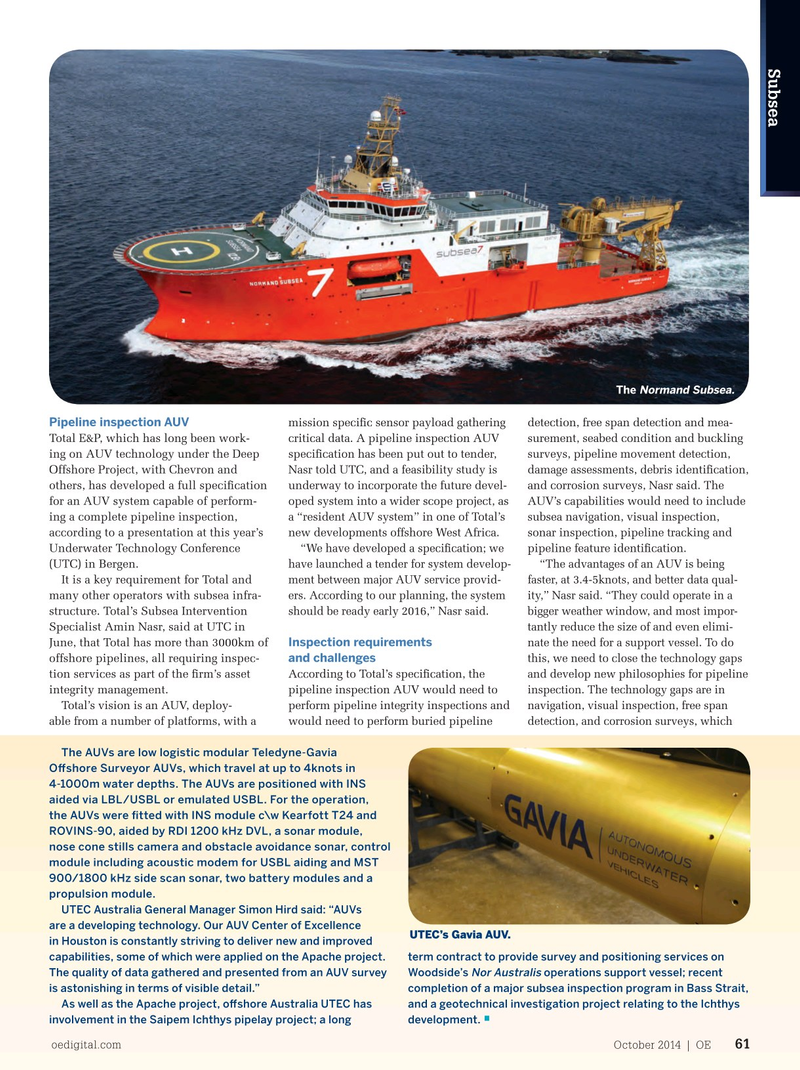
Page 59: of Offshore Engineer Magazine (Oct/Nov 2014)
Read this page in Pdf, Flash or Html5 edition of Oct/Nov 2014 Offshore Engineer Magazine
SubseaEyebrow technology integration process,’ and the trials anticipate the development of future AIV applications with which to support the inspection of Shell’s subsea facilities,” Subsea 7 said.
For the purposes of the trial, the
AIV system was incorporated into the vessel’s deployment systems and launched through the vessel’s moon- pool. The trials were conducted in paral- lel with planned inspection tasks being
The Normand Subsea.
conducted by Subsea 7 ROVs, which were also deployed from the vessel.
Pipeline inspection AUV
The trial included a series of deploy- mission speci? c sensor payload gathering detection, free span detection and mea- ment and recovery missions, with Total E&P, which has long been work- critical data. A pipeline inspection AUV surement, seabed condition and buckling autonomous subsea launch and basket ing on AUV technology under the Deep speci? cation has been put out to tender, surveys, pipeline movement detection, dockings, fully autonomous navigation Offshore Project, with Chevron and Nasr told UTC, and a feasibility study is damage assessments, debris identi? cation, and inspection activities. others, has developed a full speci? cation underway to incorporate the future devel- and corrosion surveys, Nasr said. The “Data was also obtained and will be for an AUV system capable of perform- oped system into a wider scope project, as AUV’s capabilities would need to include used to supplement and support ? nal ing a complete pipeline inspection, a “resident AUV system” in one of Total’s subsea navigation, visual inspection, further development activities within the according to a presentation at this year’s new developments offshore West Africa. sonar inspection, pipeline tracking and “We have developed a speci? cation; we ongoing AIV program,” Subsea 7 said. Underwater Technology Conference pipeline feature identi? cation. have launched a tender for system develop- “The advantages of an AUV is being
The AIV has been designed using (UTC) in Bergen. ment between major AUV service provid- faster, at 3.4-5knots, and better data qual- computational ? uid dynamics and has It is a key requirement for Total and ers. According to our planning, the system ity,” Nasr said. “They could operate in a a unique station-keeping system and many other operators with subsea infra- should be ready early 2016,” Nasr said. bigger weather window, and most impor- remote decision-making software. The structure. Total’s Subsea Intervention tantly reduce the size of and even elimi-
MK-1 speci? cation was rated to 3000m Specialist Amin Nasr, said at UTC in
Inspection requirements nate the need for a support vessel. To do water depth, and could run for 24 hours, June, that Total has more than 3000km of and challenges this, we need to close the technology gaps or a 40,000m excursion, depending on offshore pipelines, all requiring inspec- and develop new philosophies for pipeline conditions. A future development of the tion services as part of the ? rm’s asset According to Total’s speci? cation, the inspection. The technology gaps are in
AIV could see intervention equipment integrity management. pipeline inspection AUV would need to navigation, visual inspection, free span added, increasing its capabilities and Total’s vision is an AUV, deploy- perform pipeline integrity inspections and detection, and corrosion surveys, which potential applications. able from a number of platforms, with a would need to perform buried pipeline
The AUVs are low logistic modular Teledyne-Gavia
O

 58
58

 60
60